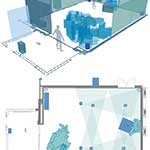the exquisite resonance of memory
Bonemap has taken the emphatically ordinary suitcase as an emblem for the events and relationships of the past. Hundreds of suitcases were used to create organic structures that represented topographical landmasses, navigable as though on a voyage of discovery through the space of the gallery. Imbued with the odour of many journeys—of departures and arrivals, of age and storage, these suitcases were sentient reminders of our post-colonial community’s disparate origins. As suggested by Bridget Elliott and Anthony Purdy (2005),
As a symbol, the suitcase is double-edged, ambivalent in the extreme: on the one hand, it evokes travel, displacement, emigration, exile and transience; on the other, it is that part of home that travels with us, a reminder of belonging and stability, the world of things we collect around us, the promise of continuity in the midst of change, of order restored. The suitcase is a portable heterotopia, an 'other space' that is always there and here at the same time, a home away from home, but also offering the endless possibility of new departures, whether desired or forced.
Through juxtaposition with the traditional European ‘cabinet of curiosities’, a predecessor of the modern museum—the Wunderkammer, and Vanitas iconography, along with the seventeenth century visual arts genre of still life painting incorporating memento mori, the work connected with the visual elaboration of the Baroque language of metaphor. This was characterised by the visual elucidation of messages that remain a potent tradition—the presence of life in the passage of time and as a reminder of mortality. In direct reference to the genre, skulls and clock hands symbolised the inevitability of death, while musical instruments signified the fleeting pleasures of life, broken strings—discord and string instruments without strings—silence. Flowers and insects suggested the ephemeral quality of life in the continuum of time and the empty vessels implied absence.
The mimetic tradition in art was also referenced strongly in the work through the temporal moving image projections of a female body caught in the multiple and uncertain life of mirrors. The rich cognitive effects amplified the ambiguity between form and pattern seemingly contemptuous of the philosophical differences between fine art and decoration. However, visual pattern was in itself a significant trigger for memory.
Both the Wonderkammer and the Vanitas genre were popular inventions of the Dutch Baroque and it was at this time in 1606, during the European “voyages of discovery” that the Dutch East India Company commissioned the Duyfken captained by Willem Janszoon, to search for "south and east lands" beyond the furthest reaches of their known world. Leaving from Banda (Indonesia), Duyfken reached the Cape York Peninsula and charted 300km of the coast. This was the first historically recorded voyage to Australia. For the first time, all the inhabited continents of the world were discovered to the European science of geography (Meyer & Wipperfurth 1995).
The Exquisite Resonance of Memory was a work about how memories are encountered through provenance and circumstance. The manifestation of collective or cultural memory through reframing the visual representation of the Baroque (to pin-point a time of early European awareness of the Australian continent) reflected on the role memory plays in lending form and consequence to our idea of self.
The work dramatised the way memory functions through association, leaps, or dislocated to become the shadows of ideas and how the more profound of these occurrences gave us a new understanding of our relationship with the world.
Russell Milledge 2008
Reference List
Elliot, B & Purdy, A 2005, 'Man in a Suitcase: Tulse Luper at Compton Verney', Image [&] Narrative, no. 12.
Meyer, AJP & Wipperfurth, O 1995, Oceanic art: Ozeanische Kunst = Art Oceanian, Konemann, Koln.
intermedia installation
A room that pulsated with a world in reverse. Suitcases served as places of accumulation and as an emblem for events and relationships of the past, each with its history of journey, memory and circumstance. Objects of provenance and museum stasis take on the aura of traditional icons.
Video wallpaper adorned the room with a theatrical representation of the temporal body caught in the multiple and inconsistent life of mirrors, where through the poetics of surprise a sinister metamorphosis occured.
The Exquisite Resonance of Memory allowed the artists to explore the Baroque and Surrealist genres in the context of Media Arts practice.
artists:
Russell Milledge, Rebecca Youdell and Steven Campbell
Centre of Contemporary Arts, Cairns 2008
sponsors:
KickArts Contemporary Art, Arts Queensland, James Cook University
Video document:













